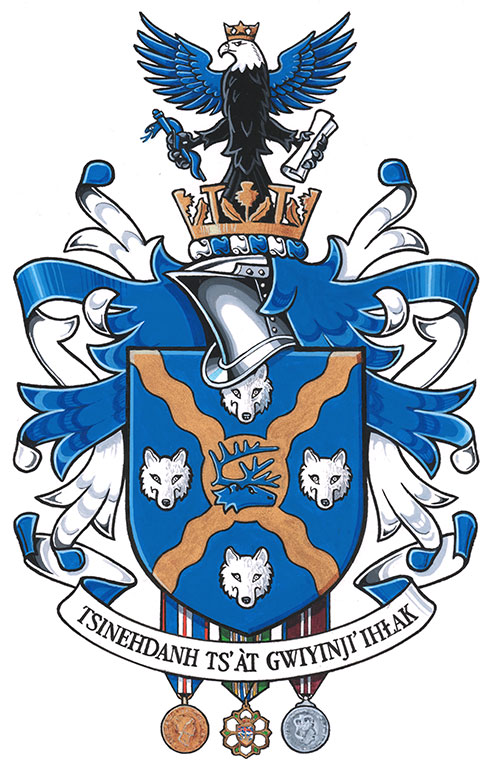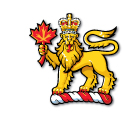- The Governor General of Canada

The contents of this Register are intended for research purposes only. The heraldic emblems found in the Register may not be reproduced in any form or in any media without the written consent of the Canadian Heraldic Authority and/or the recipient.
Vallance Jane Florence Dimsdale Knott Hungerford
Vancouver, British Columbia
Grant of Arms, Flag and Badge, with differences to George Nairn Farrell Hungerford, Michael Lyall MacLaren Hungerford, Andrew William Murdoch Hungerford and Wallace Jane Mary MacKay Hungerford
September 20, 2018
Vol. VII, p. 113

[ previous page ]
Blazon
Arms
Azure on a saltire wavy nowy Or between four Mackenzie Valley wolves’ heads caboshed Argent, a Porcupine caribou’s head erased contourné Azure;
Crest
A bald eagle displayed Sable head Argent winged Azure wearing a coronet of mullets Or holding in its dexter talons a rod of Aesculapius Azure and in its sinister talons a scroll Argent, all issuant from a circlet of thistles and iron spikes Or;
Motto
TSINEHDANH TS’ÀT GWIYINJI’ IHŁAK;
Symbolism
Arms
The blue field and the saltire, reminiscent of Scotland’s flag, represent Mrs. Hungerford’s Scottish ancestry. As well, the blue represents the sky and waters of the great northern lands which are the homeland of her Gwich’in ancestors, while the wavy strips represents the great river systems where her family has lived (the Mackenzie, Yukon, Saskatchewan, and Fraser). The wolf is an important totemic figure among the Gwich’in and the four wolf heads represent her children, and by extension, the importance of family. The Porcupine caribou is the symbol of the Gwich’in Nation.
Crest
The bald eagle is a bird to which Mrs. Hungerford feels close and is common on the Sunshine Coast of British Columbia. The silver stars allude to her American birth. The rod of Aesculapius symbolizes generative energy and power to heal, and refers to her volunteer involvement in the community in support of cancer research and medical care. The scroll represents a diploma, symbolizing the importance of education for her. The thistles recall her Scottish ancestry. The iron spikes allude to her ancestor William N. Shaw, an engineer, who was involved in building the Canadian Pacific Railway, and to her ancestors who were present at the Last Spike in Craigellachie, British Columbia.
Motto
This phrase in Gwich’in means “Peace and harmony.”
